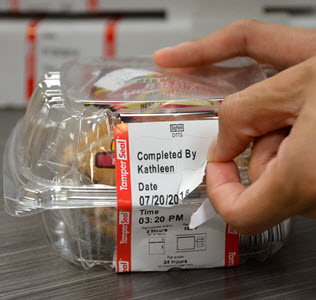Questions and Answers About Tamper-Evident Labels and Seals
Posted on 14th Sep 2018

Most of us are familiar with tamper-evident labels and seals. Things we use every day such as over-the-counter drugs, food items, packaging materials, cleaning solutions and laundry products now often have tamper-evident labels.
While some manufacturers apply tamper-evident labels to their products to ensure their safe use, many manufacturers are now required to have these labels and seals on their products.
Because they are found on so many products and because we can expect this number to grow in years to come, this might be a good time to get a better understanding of what this packaging method is all about. Here are some key things we should know about these labels and seals:
What is a tamper-evident label or seal?
As defined by the Food and Drug Administration (FDA), a tamper-evident label or seal "is one having one or more indicators or barriers to entry which, if breached or missing, can reasonably be expected to provide visible evidence to consumers that tampering has occurred."
The FDA goes on to say that the indicator or barrier must be "distinctive by design." This means the tamper-evident feature is designed from material not readily available to the public. “Therefore, it can't be easily duplicated.”
What is the “visible evidence” that a tamper-evident seal provides?
While this may vary by type and manufacturer, tamper-evident seals manufactured by DayMark Safety Systems have security slits. These are cuts on the surface of the label that tear if someone attempts to open the container, making it visibly obvious the package has been opened.
Are tamper-resistant and tamper-evident labels and seals the same?
No, they are not, and this does cause a lot of confusion. A tamper-resistant label or seal is designed to deter tampering with a product. However, it does not necessarily provide visual evidence that a product has been tampered with.
A tamper-evident label, on the other hand, as described by the FDA, does provide visible evidence that a product has been tampered with if the seal is broken in any way.
Where can we expect to see more tamper-evident labels and seals in the future?
Consumers are most likely to see more and more tamper-evident labels and seals on home and office food delivery products. These food items are delivered from restaurants, food service outlets, and the like. One reason we can expect this is the recent spate of news about delivery people helping themselves to the food they are in the process of delivering. But the principal reason is that restaurants and food service outlets want to make sure the food they prepare for their customers is delivered intact and safe.
Is there anything written on these labels?
Again, this can vary. However, with DayMark’s MenuPilot™ platform, tamper-evident labels can include information such as the restaurant or food service company’s logo, a web address, safe handling instructions, date and time the food was cooked, and many other types of customized information (including marketing materials to nutritional information).
What is the key benefit of tamper-evident labels and seals?
Safety and peace of mind. Especially when it comes to food delivered to a home or office, consumers want to make sure their food orders are appetizing, delivered within a reasonable amount of time, and safe to eat. Above all, they want to know the food has not been tampered with in any way between the time it left the food service kitchen until it reached their home or office front door.
For more information on DayMark Safety Systems tamper-evident, TamperSeal™ labels, contact a DayMark representative.


